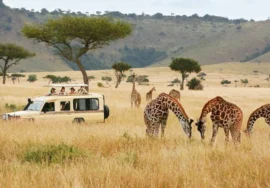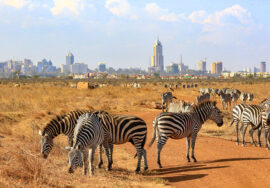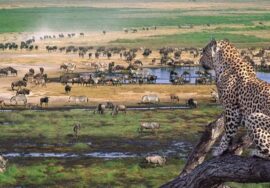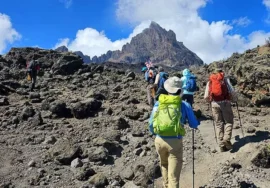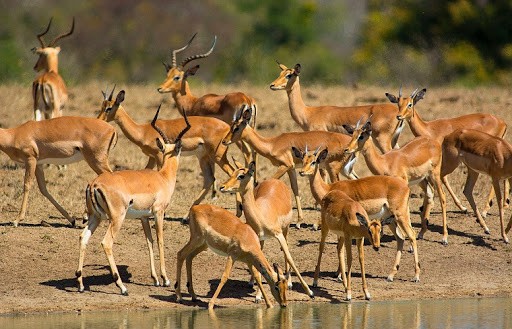
Your Complete Guide to Impalas
Your Complete Guide to Impalas, A look at the Impala, a symbol of the Savannah
Here is all the information you need about impalas, which are one of the most famous and beautiful antelopes in the African desert. Impalas are often seen on trips in Kenya and Tanzania. They are known for being quick, having unique markings, and being friendly.
We’ll learn some interesting facts about impalas, look at where they live and what they do, and answer some of the most common questions. This page will help you learn more about impalas and their important role in the African environment, whether you’ve been on a safari before or this is your first time. Let Safari Trips to Kenya take you on your next safari trip to get closer to these beautiful animals.
Ten interesting facts about impalas
1. Impalas can jump quickly
Impalas are famous for how high they can jump. They can jump up to 10 feet high and cover 30 feet when they are running away from danger. They can quickly get to higher ground or thick greenery to get away from danger thanks to their agility.
2. Impalas live in groups called herds.
Impalas are very social animals and usually live in groups of 10 to 100. Most of the time, these groups are made up of females and their young. During breeding season, powerful males set up temporary territories.
3. Impalas have unique markings
The impala has a reddish-brown body with black spots that make it stand out. These spots are on its legs, face, and tail. These marks not only make them look better, but they also help other animals in the group find them.
4. They have men who work in the regions
During breeding season, male impalas are very protective and use loud calls and scent marking to show who is in charge. They will fight other males in their area over the right to mate with females.
5. Impalas eat plants.
Impalas are herbivores that eat mostly leaves, grass, and bushes. Because they like soft grasses, they are an important part of the environment because they help keep the balance of plants in savannahs.
6. Impalas have evolved a lot to help them avoid being eaten.
To stay away from danger, impalas use their sharp senses and quick movements. Their big eyes give them a wide field of view, which lets them see lions and cheetahs coming from far away and run away quickly.
7. Male impalas compete for females
The impala’s breeding season, or rut, usually happens when it rains a lot and there is lots of food. Males often fight fiercely head-to-head during this time to show who is the boss and get access to the females.
8. They can live up to 15 years.
In the wild, impalas usually live between 12 and 15 years, but many of them are killed by lions, cheetahs, and wild dogs. Their speed and agility are their main defenses against predators, but the group also helps them stay safe.
9. Impalas can deal with living in a variety of places
Impalas are very flexible animals that can do well in a wide range of environments, from forests to savannahs. Because they can live in both dry and wet places, they are one of the most common and successful antelopes in East Africa.
10. Impalas talk to each other by making a lot of sounds
Aside from snorts and grunts, impalas also use alarm calls and other sounds to talk to each other. These sounds help other animals in the group know when there is danger or other threats, so they can run away quickly if they need to.
Are impalas a species that needs to be saved?
It’s not thought that impalas are a threatened species. The International Union for Conservation of Nature (IUCN) even calls them “Least Concern” because their numbers are stable and spread out across East Africa, mostly in Kenya and Tanzania. In both countries, national parks like Maasai Mara and Serengeti offer large protected areas where impalas can live and grow in their natural environment. These areas are made better for wildlife by conservation efforts and laws that protect wildlife.
Kenyan national parks like Amboseli, Tsavo, and Maasai Mara take care of big groups of impalas to make sure they stay around. Antelopes can graze and have babies in these parks because they are safe places where they won’t be poached or lose their home. Kenya’s focus on protecting wildlife through ecotourism and running national parks has made it possible for impalas to do very well there.
In the same way, the Serengeti, Ngorongoro Crater, and Tarangire National Park in Tanzania are home to healthy impala populations that help keep the species stable as a whole. Predators, conflicts between people and animals, and habitat loss are all things that can hurt impalas. However, ongoing conservation efforts in both Kenya and Tanzania, such as community participation and measures to stop poaching, help to protect and maintain their wild populations. Because of this, impalas are still a popular and hardy species in these areas.
FAQs about the Impala: All the answers you need!
Just what are impalas?
The impala is a medium-sized antelope that lives in the savannas and forests of Africa, mostly in Kenya and other similar places. They are very quick and can jump long lengths to get away from danger. Impalas are social animals that often live in groups. They eat mostly grass, fruits, and leaves, which makes them an important part of the environment.
And where can you find impalas?
In sub-Saharan Africa, impalas live in grasslands, savannahs, and lightly wooded places. They are most common in Kenya, Tanzania, and South Africa. They do best in places with water and a variety of grasses and bushes that they can graze on and browse. They live in a wide range of environments, from open plains to places with few trees. This makes them very good at adjusting to new environments.
What do you call a group of impalas?
Sheep that live together are called a herd. Herds are usually made up of females and their young, with a dominating male protecting them from other animals that want to mate with them. When they are not fighting over territory or power, male impalas may also gather in groups called “bachelor herds.”
What’s their top speed?
It is possible for an impala to go as fast as 37 miles per hour (60 km/h). They can get away from dangerous animals like lions and cheetahs because they are so quick and agile. Impalas are also very athletic and can jump up to 10 meters (33 feet) in a single bound.
What is an impala’s food?
Impalas are both grazers and browsers because they eat different kinds of plants, leaves, and herbs. Their food changes with the seasons. When it’s wet, they eat tender plants, but when there isn’t much grass, they eat the leaves of shrubs and trees. Because they are so flexible, they can do well in a wide range of settings across Africa.
How long do impalas live?
In the wild, an impala lives for about 12 to 15 years, based on its surroundings and the risk of being eaten. Because they can get food and feel safe better in safe places like parks or zoos, they can live up to 17 years longer. Their longevity is greatly affected by things like the quality of their environment and the presence of predators.
How many impalas are there?
The world’s impala population is thought to be around 2 million, with about a quarter of them living in protected areas in Botswana, Kenya, South Africa, Tanzania, Zambia, and Zimbabwe. The stable population shows that conservation measures are working, but the black-faced impala subspecies is still at risk because there are less than 1,000 of them left in the wild.
There are no horns or antlers on impalas.
They don’t have antlers; they have horns. The horns of male impalas are long and curled, and they can grow up to 36 inches (91 cm) long. Female impalas do not have horns. Antlers are shed every year, but impala horns stay on all year and are used by males to show authority and defend themselves.
How far can an impala jump?
This animal can jump up to 10 feet (3 meters) high. Their speed is well-known, and they can jump up to 30 feet (9 meters) in a single bound. They can jump very high, which helps them avoid being eaten and find their way around in the grasslands and woodlands where they live.
What is the name for a male impala?
This animal is male and is called a ram. During the breeding season, rams often fight head-to-head to show who is the boss and get to mate with females. Rams have long, bent horns that make them easy to spot. These horns show how strong and important they are in the herd.
What is the name for a female impala?
Emu females are called ewes. Most of the time, ewes and their young live in groups called herds, where they feed and raise their young. Ewes don’t have horns like males do, and they are very important to the impala herds’ social system and lives.
What do you call a young impala?
“Lamb” is the word for a young impala. Most impala lambs are born during the wet season, and they can stand and walk right away. For safety and food, they stay close to their moms and learn to graze as they get older.
Is it because they live in groups?
It’s safer for impalas to live in groups, so they do. This helps keep them safe from animals that might try to eat them. Impalas can warn each other about danger in herds, which increases their chances of survival by working together to get away. Living in groups also makes it easier to get things like food and water, which helps the young and weak have a better chance of life.
Kenya has many national parks. Which ones have impalas?
Maasai Mara, Amboseli, Tsavo, and Lake Nakuru are all national parks in Kenya where you can see impalas. With their large fields and forests, these parks are perfect places for impalas to live and graze. In these parks, people can see impalas in their natural habitat, where they often live in big groups.
In what Tanzanian national parks can you find impalas?
Serengeti, Ngorongoro Crater, and Tarangire are some of Tanzania’s national parks where you can see impalas. These parks have a lot of open plains and wooded areas where big groups of impalas can be seen grazing. Some of the best places to see these graceful antelopes in their natural environment are in Tanzania’s protected areas.
When is the best time of year to see impalas?
From November to April, when it rains a lot, is the best time to see impalas. This is when the grass is thick and full, giving impalas plenty to eat, and a lot of lambs are born. At this time of year, impalas are often seen in bigger groups, which makes for great chances to see wildlife.
Can I go on vacation and see impalas?
Going on tour in Kenya or Tanzania is a good way to see impalas. You can often see these beautiful antelopes in national parks like Maasai Mara, Serengeti, and Amboseli. They do best in fields and forests. People who go on safari can see impalas feeding in groups and showing off their amazing agility.
Interested in Impalas? View an Impala in real life by going on a safari!
Reading about impalas is an interesting way to learn about their graceful and quick lives, but seeing them in the wild is even more exciting. One of the most beautiful things about these antelopes is seeing them graze quietly in groups or jump across the savannah with ease. Safari Trips to Kenya can take you on a unique trip to some of Africa’s most famous national parks, where you can see impalas and other amazing animals up close. We can help you have a trip you’ll never forget!


